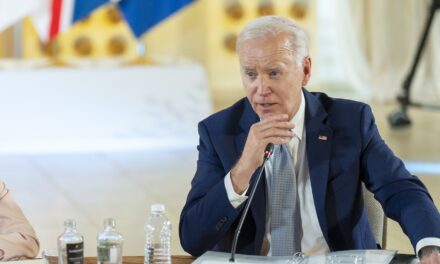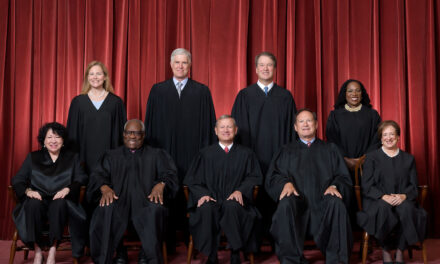We support our Publishers and Content Creators. You can view this story on their website by CLICKING HERE.
Joe Biden’s unprecedented “basement” presidential campaign in 2020 and the chaotic election that followed represented a stunning repudiation of U.S. election norms as they have evolved over the last 250 years. The chaos involved a flurry of legally questionable and last-minute suspensions of existing election rules and an avalanche of unsupervised mail-in ballots in states that were not accustomed to their use. The election also brought the formerly obscure practice of “ballot harvesting” to the forefront of popular consciousness.
Amidst the chaos, one of the biggest questions remaining is how the Center for Tech and Civic Life (CTCL) — a sleepy, Chicago-based election and civic “engagement” nonprofit, armed with a staggering sum of more than $300 million from tech billionaire Mark Zuckerberg — became one of the key 2020 election players. CTCL’s officers, promoters, and donors were among the “well-funded cabal of powerful people” who, as Time Magazine admitted in 2021, worked “behind the scenes” to “fortify” the 2020 election against Donald Trump.
Many Republican election watchers have long been scratching their heads, wondering if there is something that ties CTCL to something more nefarious than taking advantage of a legal gray area to help local election offices with “COVID-19 Response” during the 2020 election.
Our research revealed that, while election safety during Covid may have been the stated reason for CTCL’s program, this was not its purpose.
CTCL’s $332 million-plus election funding effort (also known as “Zuckbucks”) influenced election offices in critical Democrat areas in 2020 through large, “strings attached” CTCL grants. Ultimately, the evidence suggests that its purpose was to win the election for Joe Biden at the electoral margin in the swing states. This puts the organization in a legally vulnerable position, and Republican legal officials and lawmakers who care about U.S. election integrity should take advantage.
CTCL Is a 501(c)(3) Nonprofit Barred From Partisan Activity
Twenty-eight states have enacted legislation that restricts or prohibits the private financing of elections, but CTCL has remained largely above the fray since the 2020 election. The organization and its associates must be held accountable for past illegalities and illegalities yet to be determined. Understanding the full extent of the misbehavior and “dirty tricks” that occurred during the 2020 election will involve learning it, under oath, from the people who made it happen.
On the bright side, CTCL’s money trail has been well documented with publicly available data, and it displays patterns of intense partisanship at the state and national levels in ways that seem inconsistent with CTCL’s charter as a 501(c)(3) nonprofit.
Hundreds of millions of dollars flowed across state lines between June 2020 and October 2020 through sophisticated, private financial channels that have yet to be specified. There are vast troves of yet-to-be-examined electronic communications that took place during the summer and fall of 2020 while grant applications were solicited, funds were distributed, and advice was circulated regarding the use of those funds in winning the election for Joe Biden.
There is much that can be learned about the election through the state’s subpoena and investigative powers that private citizens would never know.
It is time for red state legal officials and lawmakers to think seriously about employing their prosecutorial power to sort out the unprecedented role that CTCL played in the 2020 election. State courts and the U.S. tax courts (for 501(c)(3) U.S. Tax Code violations) are promising venues through which to file charges against CTCL, its officers, and administrators.
Debunking the Myth of CTCL’s ‘Nonpartisanship’ in 2020
The $332 million that Facebook founder Mark Zuckerberg and his wife Priscilla Chan provided to CTCL to “assist” with the 2020 elections was distributed on a highly partisan basis that heavily favored Democrats.
Large CTCL grant recipients, such as Wisconsin, agreed in exchange for funding to “encourage and increase absentee voting,” mainly by providing “assistance to help voters” in absentee ballot completion and by installing ballot drop boxes to dramatically “expand strategic voter education & outreach efforts, particularly to historically disenfranchised residents.”
While CTCL grants were touted as a resource meant to help all jurisdictions administer the election during the Covid pandemic, CTCL’s 2021 tax records show that the group “awarded all larger grants — on both an absolute and per capita basis to deeply Democratic urban areas,” and that “[t]his partisan pattern of funding was especially apparent in swing states.”
In the counties where CTCL made its 50 largest grants per capita, the average partisan lean in favor of Democrats was 33 points, which corresponds to a 67 percent Democrat to 33 percent Republican vote breakdown. What’s more, of CTCL’s 10 largest grants per capita, seven were given to key urban counties and cities in Georgia and Wisconsin. Biden narrowly won these two swing states in 2020 — by no more than 12,000 votes and 21,000 votes respectively.
In other words, the bulk of the money was spent in a sophisticated and novel effort to mobilize the mail-in ballots of specific voter profiles to benefit Democratic candidates, and the distribution of the largest CTCL grants ultimately increased Democrats’ partisan advantage in the electoral college.
As we found in our research, deep blue states with no chance of favoring Trump like Colorado and Vermont, as well as solid red states opposed to Biden like Tennessee and Utah, received very little CTCL funding — only around $0.10 per capita. However, swing states key to Joe Biden’s electoral college strategy like Georgia, Pennsylvania, and Wisconsin were lavished with tens of millions of dollars in CTCL money averaging between $1 and $2 per capita. Georgia, the top CTCL grant recipient, received a whopping $41 million — roughly $4 per capita — the lion’s share of which went to only seven deep blue metro Atlanta counties out of the state’s 159.
This data conflicts with the often-heard assertion that “more Republican jurisdictions, defined as municipalities that voted for Trump in 2020, applied for and received grants from CTCL” than Democratic jurisdictions.
Republican jurisdictions often received small grants of less than $50,000 (usually around $5,000), which were not large enough to materially affect their election practices and made up only 27 percent of CTCL’s “total spending.” These smaller grants appear to be part of a public relations strategy to foster the illusion of nonpartisanship amid a sophisticated, highly partisan effort.
Debunking The Myth of ‘Underfunded’ Urban Election Offices
Among CTCL apologists, another argument that has repeatedly made the rounds is that big CTCL money was used to address so-called funding shortfalls in urban-based, deep blue election offices where it is supposedly more costly to run an election than in less populated areas. But there is no evidence of a systematic relationship between CTCL grant amounts and the public “underfunding” of election offices in Democratic areas.
Drawing a precise distinction between well-funded and underfunded election offices during the hectic late summer and early fall of 2020 — when CTCL grants were being decided and funds dispersed — would have been subject to a fatal time crunch. There is no evidence that a grant applicant’s level of state funding relative to other election offices was even considered or provided by the grant applicant during the application process. There is also no evidence to suggest that the recipients of large CTCL grants were systematically underfunded in election administration. For example, when we examined the state and federal election budgets of Wisconsin, one of the five states that together received 25 of the top 50 grants per capita, we were surprised to find some of the most well-funded election offices by state standards.
And once again, big CTCL grant recipients in heavily Democratic areas not only got larger grants, but they received far more CTCL funding per capita than smaller grant recipients. Of the six largest CTCL grant recipients, the average election budget was $5.61 per capita, and among the next 5 largest Wisconsin cities, it was $2.64 per capita.
CTCL singled out some of the most well-funded election offices in Wisconsin for its largest grants. There is no reason for the per capita cost of running elections to be higher in urban areas. On the contrary, highly voter-concentrated areas should mean that the “substantial fixed cost of election administration is spread out over a relatively larger population, decreasing the per capita cost.”
No Such Thing as ‘Nonpartisan’ Voter Outreach
Some CTCL apologists, like The Washington Post’s outlandish Philip Bump, have argued that CTCL should be applauded, claiming the organization intended to address disparate voter turnout rates between white voters and racial minorities. Indeed, CTCL early on encouraged its large grant recipients to “Expand Strategic Voter Education & Outreach Efforts, Particularly to Historically Disenfranchised Residents” through various “nonpartisan” efforts. But such efforts will almost always be partisan in their effect, even if they are entirely devoid of partisan content.
Election officials are familiar with the political characteristics of their own populations. An election official in Dallas, Texas knows that her jurisdiction voted 65 percent Democrat and 34 percent Republican in 2020. Thus, in her county, for every 100 additional voters, the expected distribution of Biden to Trump votes is 65 to 35 — an increase of Biden’s margin by an average of 30 votes.
If this election official is successful in turning out an additional random distribution of 100,000 voters in her jurisdiction, she will have padded Biden’s margin by an additional 30,000 votes, even if all she does is say “Vote!” The “partisan” nature of any get-out-the-vote operation does not wholly depend on the message, but on the audience to whom the message is directed.
It may or may not be the case that more “historically disadvantaged” individuals should vote. What is not up for dispute is that it is not the job of election administrators to boost voter turnout. “Turnout” is something that election officials should take as a “given” data point, rather than a variable to be determined by their actions during an election.
Time to Investigate CTCL’s Election Interference
CTCL was involved in a conspiracy to interfere in the 2020 election using legally questionable means. Even if private election grants were technically “legal” in 2020, the ability to exercise outside influence over the operation of the election system is not something that should be for sale to the highest bidder, ever.
Those who oppose the legal prosecution of CTCL will have to explain why systematic misbehavior during the 2020 election must never be allowed to see the disinfectant light of day in the courtroom as well as clarify why wealthy and powerful leftists should be shielded from having their actions during the 2020 election examined under oath.
William Doyle, Ph.D., is research director at The Caesar Rodney Election Research Institute in Irving, Texas. He specializes in economic history and the private funding of American elections. Previously, he was associate professor and chair in the department of economics at the University of Dallas. He can be contacted at doyle@rodneyinstitute.org.

 Conservative
Conservative  Search
Search Trending
Trending Current News
Current News 





